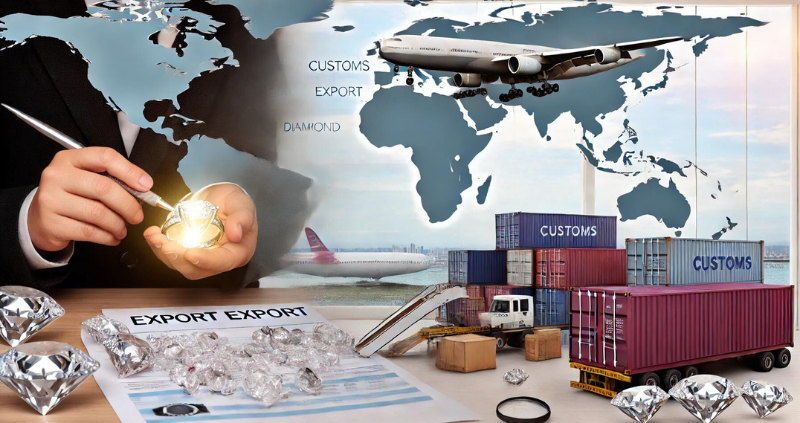Navigating the Diamond Export Process: A Comprehensive Guide
The diamond export process is intricate, involving several stages and regulations to ensure compliance and quality.

The diamond export process is intricate, involving several stages and regulations to ensure compliance and quality. This guide will walk you through the essential steps and considerations for exporting diamonds, covering the critical stages of diamond processing, the requirements for becoming a certified exporter, and the detailed steps to follow for a successful diamond export.
What Are the Stages of Diamond Processing?
Before diamonds can be exported, they must go through several processing stages to enhance their quality and value:
- Mining and Sorting:
- Mining: Diamonds are extracted through methods like open-pit, underground, and alluvial mining.
- Sorting: Rough diamonds are sorted based on size, shape, quality, and colour, determining their potential market value.
- Cleaving and Sawing:
- Cleaving: Larger rough diamonds are split into smaller pieces using a steel blade.
- Sawing: Diamonds that cannot be cleaved are sawed using lasers or diamond saws to shape them for further cutting and polishing.
- Cutting and Bruting:
- Cutting: Diamonds are carefully cut into specific shapes (e.g., round, princess, emerald) using advanced technology.
- Bruting: This process smooths the diamond's girdle, rounding it out for a polished finish.
- Polishing: Polishing involves meticulously grinding and finishing the diamond's facets to enhance its shine and sparkle.
- Grading and Certification:
- Grading: Diamonds are graded based on the 4 Cs: Carat weight, Cut, Colour, and Clarity.
- Certification: Reputable gemological laboratories (e.g., GIA, AGS) issue certificates detailing the diamond's characteristics.
How to Become a Diamond Exporter?
Becoming a diamond exporter involves several steps to ensure compliance with industry standards and regulations:
- Research and Education:
- Understand the diamond industry, including market trends, quality standards, and export regulations.
- Consider enrolling in courses or certification programs offered by gemological institutes.
- Business Registration: Register your business with the relevant government authorities and obtain the necessary licences and permits.
- Supplier Relationships: Establish relationships with reliable diamond suppliers and ensure they adhere to ethical sourcing practices.
- Compliance with International Regulations: Familiarise yourself with international trade regulations, such as the Kimberley Process Certification Scheme (KPCS), to ensure your diamonds are conflict-free.
- Quality Assurance: Implement strict quality control measures to ensure your diamonds meet the highest standards.
- Networking and Market Research: Attend trade shows and industry events to connect with potential buyers and partners, and conduct market research to identify target markets.
Steps to Follow for Diamond Export
Exporting diamonds involves a series of steps to ensure compliance with international trade regulations and smooth logistics:
- Preparation and Documentation: Prepare necessary documentation, including invoices, packing lists, and certificates of origin. Obtain a Kimberley Process Certificate (KPC) to certify that your diamonds are conflict-free.
- Customs Clearance: Submit your export documentation to the relevant customs authorities for clearance and pay any applicable export duties and taxes.
- Logistics and Shipping: Choose a reliable logistics provider experienced in handling high-value shipments. Ensure your diamonds are securely packaged and insured.
- Compliance with Import Regulations: Familiarise yourself with the import regulations of the destination country and work with import agents or customs brokers to facilitate the import process.
- Delivery and Verification: Upon arrival at the destination, the shipment will undergo customs inspection and verification. Ensure all documentation is accurate and complete.
- Follow-Up and Customer Service: Maintain open communication with your buyers and provide excellent customer service to build trust and foster long-term relationships.
Additional Important Information
- Insurance: Insure your diamond shipments against loss, theft, or damage during transit with a reputable insurance provider specialising in high-value goods.
- Ethical Sourcing: Promote ethical sourcing practices and transparency in your supply chain to enhance your reputation and align with global efforts for responsible diamond trade.
- Technological Advancements: Stay updated with technological advancements in diamond processing and grading to improve efficiency and quality control.
Navigating the diamond export process requires a thorough understanding of industry standards, regulatory compliance, and meticulous attention to detail. By following the steps outlined in this guide, aspiring diamond exporters can successfully navigate the complexities of the diamond trade, ensuring a seamless and profitable export process.

